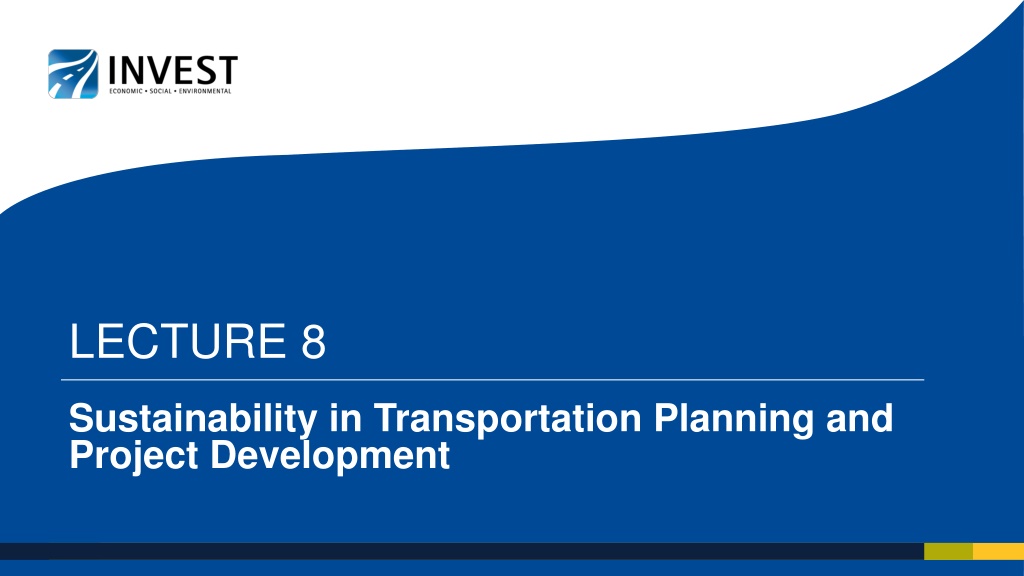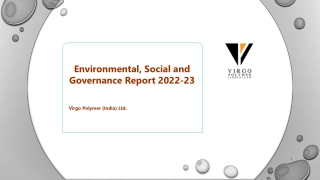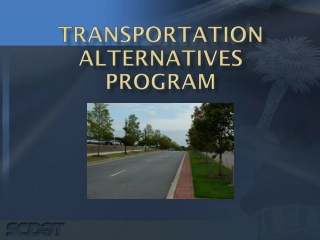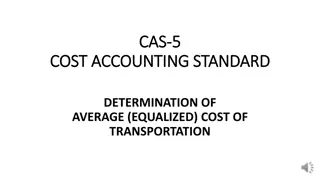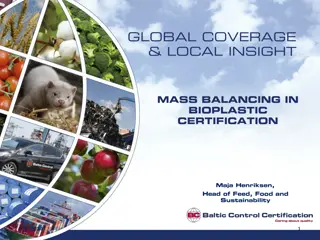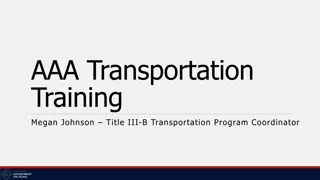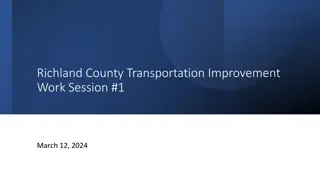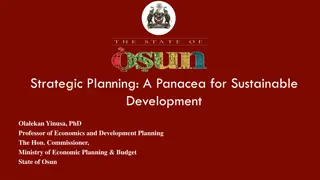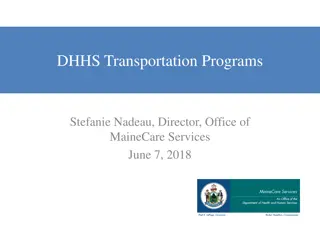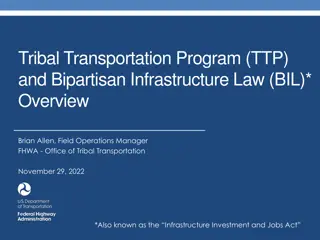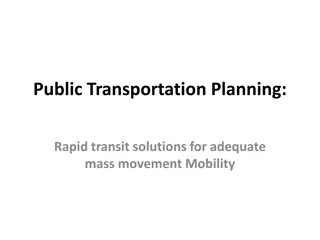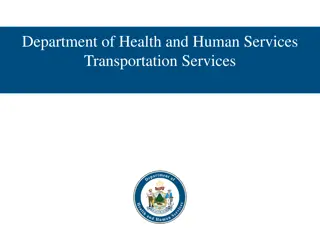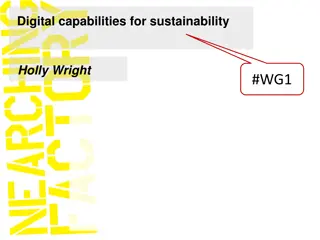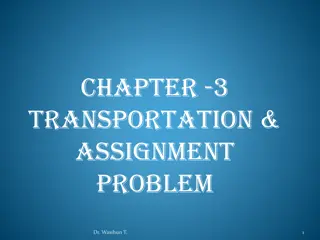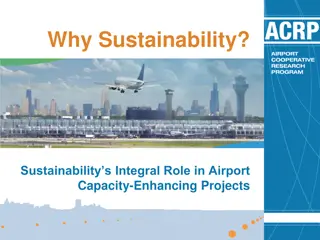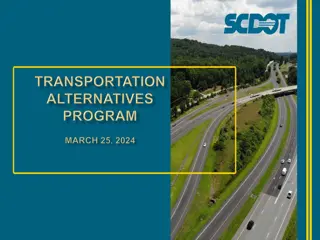Sustainability in Transportation Planning
Sustainability in transportation planning involves long-range and short-range strategies to develop a vision for investments, match projects with funds, and address community needs. This process includes environmental reviews, engineering plans, land acquisition, permitting, construction, and maintenance. Objectives and measures are set to achieve sustainability goals such as safety, accessibility, and environmental impact mitigation. Linking to sustainability goals is crucial for creating a safe and efficient transportation system that meets the needs of the public while minimizing negative impacts on the environment.
Download Presentation

Please find below an Image/Link to download the presentation.
The content on the website is provided AS IS for your information and personal use only. It may not be sold, licensed, or shared on other websites without obtaining consent from the author.If you encounter any issues during the download, it is possible that the publisher has removed the file from their server.
You are allowed to download the files provided on this website for personal or commercial use, subject to the condition that they are used lawfully. All files are the property of their respective owners.
The content on the website is provided AS IS for your information and personal use only. It may not be sold, licensed, or shared on other websites without obtaining consent from the author.
E N D
Presentation Transcript
LECTURE 8 Sustainability in Transportation Planning and Project Development
Transportation Planning and Delivery Process Long-range transportation planning Develop a vision for transportation investments Planning and Project Development Short-range transportation planning Use capital programming to match priority projects with funds Identify project needs, community concerns, and potential solutions Project-level planning Project-level environmental review Elaborate review to consider impact on environment, guided by regulations Design, land acquisition, and permitting Prepare engineering plans, purchase right of way, and obtain permits Construction, maintenance, and operations Build it and keep it working 2
Linking to Sustainability Goals The table provides a list of sustainability goals introduced previously Each focus area such as planning and project development must have its own objectives and measures The following slides present example objectives and measures for the planning and development focus areas for each goal Source: NCHRP Report 708: A Guidebook for Sustainability Performance Measurement for Transportation Agencies. National Academies Press. https://doi.org/10.17226/14598 3
Planning Objective Measure Example GOAL 1: Provide a Safe Transportation System for Users and the Public Reduce the severity of crashes Change in the number and severity of crashes Annual number of severe or incapacitating injuries on all roads Project development Objective Measure Example Develop project with explicit safety considerations Selected project design has highest reduction out of all alternatives Use of engineering measures (wildlife- proof fencing, escape ramps, and one-way gates) to keep elk (and other animals) off the highway Source: NCHRP Report 708: A Guidebook for Sustainability Performance Measurement for Transportation Agencies. National Academies Press. https://doi.org/10.17226/14598 4
Planning GOAL 2: Provide a Objective Measure Example Ensure accessibility to jobs Change in number of jobs within reasonable travel time for region s people Number of jobs accessible by auto and transit within 15, 30, and 45 minutes Transportation System That Offers Accessibility That Allows People to Fulfill at Least Their Basic Needs Project development Objective Measure Example Develop projects that increase access to essential destinations Change in travel time to schools, health services, grocery stores, civic and public spaces, and recreation due to selected project alternative Travel mode splits, travel times, and delay by county and major corridor and by regional geography (including designated centers) Source: NCHRP Report 708: A Guidebook for Sustainability Performance Measurement for Transportation Agencies. National Academies Press. https://doi.org/10.17226/14598 5
Planning Objective Measure Example GOAL 3: Ensure accessibility to jobs and essential destinations for all communities Relative change in the level of access for disadvantaged populations to jobs, schools, health services, grocery stores, civic and public spaces, and recreation Access and travel time to essential destinations by auto and transit Provide Options That Allow Affordable and Equitable Transportation Options for All Sections of Society Project development Objective Measure Example Develop transportation projects that improve transportation equitably Ratio of disadvantaged to non-disadvantaged population experiencing negative impacts of transportation (noise, air quality, and neighborhood fragmentation) Displacement from projects Source: NCHRP Report 708: A Guidebook for Sustainability Performance Measurement for Transportation Agencies. National Academies Press. https://doi.org/10.17226/14598 6
Planning GOAL 4: Ensure That the Transportation System s Functionality and Efficiency Are Maintained and Enhanced Objective Measure Example Ensure that transportation options are efficient for all users Change in travel time index by mode Travel time index calculated as the ratio of travel time in the peak period to travel time in free flow Project development Objective Measure Example Develop projects that maintain or improve the functionality of the transportation system for all users Change in volume/capacity ratio (congestion reduction per unit [lane mile]) due to project Volume-to- capacity ratio (V/C) Source: NCHRP Report 708: A Guidebook for Sustainability Performance Measurement for Transportation Agencies. National Academies Press. https://doi.org/10.17226/14598 7
Planning Objective Measure Example GOAL 5: Ensure That the Transportation System Is Secure from, Ready for, and Resilient to Threats from All Hazards Protect transportation users, agency personnel, and critical infrastructure Change in share of agency staff receiving appropriate emergency training Percent of mass transit and passenger rail agencies that have effectively implemented industry agreed-upon security and emergency management actions to improve security Project development Objective Measure Example Program projects that prevent incidents within a transportation agency s control and responsibility Change in level of redundancy for critical passenger/freight infrastructure Prioritize system redundancy plans according to the agency s strategy Source: NCHRP Report 708: A Guidebook for Sustainability Performance Measurement for Transportation Agencies. National Academies Press. https://doi.org/10.17226/14598 8
Planning Objective Measure Example GOAL 6: Ensure That the Transportation System s Development and Operation Support Economic Development and Prosperity Support growth in jobs by improving travel efficiency/reducing congestion Change in travel delay at major freight bottlenecks by mode Travel time on freight-significant corridors. Travel time index calculated as the ratio of travel time in the peak period to travel time in free flow Project development Objective Measure Example Develop projects that support growth in jobs and income by improving access to markets and factors of production (labor and raw materials) Change in population within user-defined proximity to access controlled four-lane highway facilities, air cargo service, scheduled air service, intercity bus service, intercity rail service, and so forth Number of national/international air destinations served by nonstop flights Source: NCHRP Report 708: A Guidebook for Sustainability Performance Measurement for Transportation Agencies. National Academies Press. https://doi.org/10.17226/14598 9
Planning GOAL 7: Objective Measure Example Ensure the Economic Feasibility of Transportation Investments over Time Ensure that financial burdens borne by transportation users are shared equitably Cost per user/vehicle/household of taxes/fees dedicated to transportation Taxes paid Project development Objective Measure Example Ensure that the expected value of social and economic benefits created by proposed transportation programs/projects exceeds their cost Project-level cost/benefit ratio for proposed programs, including freight Use of a cost/benefit ratio for project selection Source: NCHRP Report 708: A Guidebook for Sustainability Performance Measurement for Transportation Agencies. National Academies Press. https://doi.org/10.17226/14598 10
Planning GOAL 8: Objective Measure Example Protect and Enhance Environmental and Ecological Systems While Developing and Operating Transportation Systems Ensure that environmental and ecological systems are free of contaminants and pollutants Existence of an agency-wide environmental management system Environmental management system covers the department of public works, parks maintenance, and engineering Project development Objective Measure Example Develop projects that maintain and improve quantity and quality of water and aquatic ecosystems Change in number (percentage) of projects designed to maintain or improve water quantity or quality Mimic predevelopment hydrological conditions in the right of way Source: NCHRP Report 708: A Guidebook for Sustainability Performance Measurement for Transportation Agencies. National Academies Press. https://doi.org/10.17226/14598 11
Planning Objective Measure Example Ensure that assets are managed to reduce life-cycle cost and increase useful life An asset management system exists Tracking pavement performances to make pavements last longer by preserving and maintaining them GOAL 9: Reduce Waste Generated by Transportation-Related Activities Project development Objective Measure Example Increase the percentage of waste diverted (from landfill) from transportation projects Change in the percentage of projects with a recycling plan or waste diversion goal Utilize an accounting and management plan for road construction waste materials, and minimize the amount of construction- related waste destined for landfill Source: NCHRP Report 708: A Guidebook for Sustainability Performance Measurement for Transportation Agencies. National Academies Press. https://doi.org/10.17226/14598 12
Planning Objective Measure Example GOAL 10: Reduce the Use of Nonrenewable Resources and Promote the Use of Renewable Replacements Purchase sustainable materials as a priority Existence of purchasing plan establishing priority for sustainable materials Promoting the use of environmentally preferable products in the city s acquisition of goods and services Project development Objective Measure Example Use renewable energy to provide project power Change in percentage of renewable energy, in kWh, created in relation to project energy requirements in a project Reduce the consumption of fossil fuels during operation of highway illumination 13
Planning Objective Measure Example GOAL 11: Increase street connectivity Change in street connectivity index Increasing roadway connectivity will reduce the amount of pollutant emissions created from vehicles Reduce Transportation- Related Emissions of Air Pollutants and Greenhouse Gases Project development Objective Measure Example Develop projects that reduce pollutant emissions (travel, trip length, mode split, and emissions) Change in percentage of commercial vehicles by EPA tier compliance Reduce air emissions from non- road construction equipment by encouraging early achievement of the EPA Tier 4 emission standard Source: NCHRP Report 708: A Guidebook for Sustainability Performance Measurement for Transportation Agencies. National Academies Press. https://doi.org/10.17226/14598 14
LECTURE 8 Sustainability in Transportation Planning and Project Development
